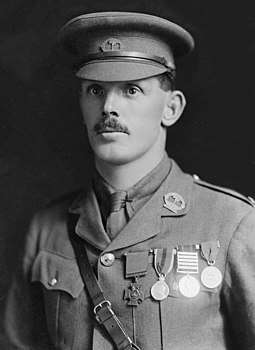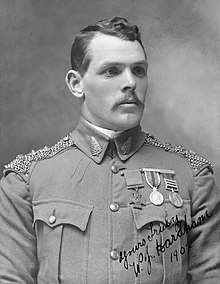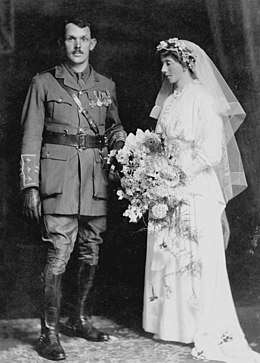William Hardham
| William Hardham | |
|---|---|
 Captain William Hardham, April 1916 | |
| Born |
31 July 1876 Wellington, New Zealand |
| Died |
13 April 1928 (aged 51) Wellington, New Zealand |
| Buried | Karori Soldier's Cemetery, Wellington |
| Allegiance | New Zealand |
| Service/ | New Zealand Military Forces |
| Years of service | 1895–1919 |
| Rank | Major |
| Unit |
4th New Zealand Contingent Wellington Mounted Rifles Regiment |
| Battles/wars |
Second Boer War First World War |
| Awards |
Victoria Cross Mentioned in Despatches |
| Other work | Rugby Union player |
Major William James Hardham, VC (31 July 1876 – 13 April 1928) was a New Zealand recipient of the Victoria Cross (VC), the highest award for gallantry "in the face of the enemy" that can be awarded to British and Commonwealth forces.
Born in Wellington, Hardham was a blacksmith and part-time soldier in the local militia when he volunteered to serve with the New Zealand Military Forces in the Boer War. Posted to the 4th Contingent in 1900, he was on a patrol in the South African Transvaal when it was ambushed. He rode to the rescue of a wounded soldier while under heavy fire and for this he was awarded the VC. Discharged from the New Zealand Military Forces in 1901, he rejoined for another period of service in the Boer War but did not return to South Africa and instead was sent to England for the coronation of King Edward VII and Queen Alexandra. Returning to civilian life, he became increasingly involved in rugby administration but also continued to serve in the militia. When the First World War began, he volunteered for service abroad with the New Zealand Expeditionary Force (NZEF) and was posted to the Wellington Mounted Rifles (WMR) as a captain. Wounded during the Gallipoli Campaign, he was repatriated to New Zealand. On recovery he was made commandant of Queen Mary Hospital in Hanmer Springs but desired a return to the NZEF and a posting overseas. He soon rejoined the WMR, then in Palestine, but his health was poor and affected the remainder of his service in the military. Discharged from the NZEF after the war, he worked for a newspaper and later the Public Works Department as well being involved in veteran's affairs. He died in 1928 at the age of 51.
Early life
Hardham was born on 31 July 1876, the son of George Hardham, a labourer, and his wife, Ann Hardham (née Gregory). He was educated in Wellington, the city of his birth, and when his schooling was completed, he obtained work as a blacksmith. A keen sportsman, he played rugby for the Petone Rugby Club, and also represented Wellington in the sport.[1] He would eventually play 53 games for the province. His military career began in 1894, when he joined the Wellington Naval Artillery, a part-time militia unit, serving with the Petone Company.[2]
South Africa

During the Second Boer War, the New Zealand Government offered the British a mounted contingent from the New Zealand Military Forces for service in the conflict in South Africa. Volunteers were plentiful and by 1900, two contingents had already left for the war.[3] Hardham was among those who volunteered and he was posted to the 4th New Zealand Contingent as a farrier sergeant major.[1] Landing in Portuguese East Africa in April 1900, the Fourth Contingent, nicknamed the "Rough Riders", were deployed as part of the Rhodesian Field Force around Mafeking. Aside from a brief action at Ottoshoop in August, the Rough Riders spent the majority of their war engaged in guerilla warfare, pursuing Boer commandos.[3]
On 28 January 1901, Hardham was on a patrol in the Transvaal when it was ambushed by 20 Boers. Although the patrol was able to withdraw, one man was wounded and his horse was shot from under him. Seeing this, Hardham rode to his aid and extracted him to safety while under heavy gunfire.[2]
For his actions, Hardham was recommended for the Victoria Cross (VC) by General Herbert Kitchener, overall commander of British forces in South Africa, even though the local commander, Major-General Ian Hamilton, believed the Distinguished Conduct Medal was a more appropriate form of recognition. However, the commander-in-chief of the British Army, Field Marshal Earl Roberts, concurred with Kitchener and the VC nomination was approved. The citation for Hardham's VC, the first to be awarded to a New Zealander of a unit of the New Zealand Military Forces serving overseas,[2] read:
On 28 January 1901, near Naauwpoort, this Non-Commissioned Officer was with a section which was extended and hotly engaged with a party of about 20 Boers. Just before the force commenced to retire Trooper McCrae was wounded and his horse killed. Farrier- Major Hardham at once went under a heavy fire to his assistance, dismounted and placed him on his own horse, and ran alongside until he had guided him to a place-of safety.[4]
Hardham was presented with the VC, the first and only such award to a New Zealander in the Boer War, on 1 July by the Prince of Wales, who was in South Africa on a visit. This event took place even before the gazetting of the award. The medal itself was not officially engraved; Hardham presumably arranged this himself later. He was discharged in August 1901 and returned to New Zealand.[2]
He volunteered for service with the Ninth Contingent and was commissioned as a lieutenant in February 1902. However, he did not make it back to active duty in South Africa. Instead he was diverted to England to join up with the New Zealand contingent attending the coronation of King Edward VII and Queen Alexandra[2] and participated in a parade of colonial troops in London on 1 July 1902.[5]
Civilian life
Hardham returned to civilian life after his visit to London and continued to serve with the Naval Artillery. In 1910, having attained the rank of sergeant and served as a volunteer in the militia for 16 years, he was awarded the Long and Efficient Service Medal. As well as his work as a blacksmith, he also increasingly became involved in rugby administration; in 1908 he commenced the first of several terms on the committee of the Wellington Rugby Union, eventually becoming a life member.[2]
First World War

On the outbreak of the First World War, Hardham volunteered for the New Zealand Expeditionary Force (NZEF), being raised for service overseas. Appointed as a captain in the Wellington Mounted Rifles (WMR), he embarked with the main body of the NZEF for the Middle East in October 1914.[2] His regiment was part of the New Zealand Mounted Rifles Brigade and would be destined for service in the Gallipoli Campaign. While the WMR missed out on the initial landings at Gallipoli, it would arrived on the peninsula on 12 May 1915, without their horses.[6] Within days, the WMR was involved in the Battle for No.3 Post and it was during this engagement that Hardham received major wounds. Another officer who came to his aid was also wounded.[7]
Although treated for his injuries, Hardham was repatriated to New Zealand in February 1916. He agitated for a return to active duty with the NZEF but instead received a post as commandant of Queen Mary Hospital in Hanmer Springs. Initially just a temporary position, he did so well in the role that it was made permanent and he was promoted to major. He still sought a role with the NZEF, and eventually in late 1917, the military authorities relented and he was able to rejoin the WMR, now serving in Palestine. His health was poor and he spent much of the remainder of the war ill.[2]
Later life and legacy
After the war, Hardham was discharged from the NZEF but sought a role in the New Zealand Military Forces as a professional soldier. His application was declined on account of his health.[2] Unable to return to his work as a blacksmith, he found work at a newspaper and later with the Public Works Department. He was involved in veteran's affairs, being a club manager at the Wellington Returned Serviceman's Association and organising ANZAC Day parades.[1]
Suffering stomach cancer, Hardham died on 14 April 1928. Survived by his wife, who he had married in 1916, he was buried at Karori Cemetery in Wellington. His VC is displayed at the QEII Army Memorial Museum at Waiouru. The Hardham Cup, a competition trophy in Wellington club rugby, is named in his honour.[2]
Notes
- 1 2 3 Crawford, J.A.B. "Hardham, William James – Biography". Dictionary of New Zealand Biography. Ministry for Culture and Heritage. Retrieved 28 January 2018.
- 1 2 3 4 5 6 7 8 9 10 Harper & Richardson 2007, pp. 85–88.
- 1 2 Harper & Richardson 2007, pp. 78–80.
- ↑ "No. 27362". The London Gazette. 4 October 1901. p. 6481.
- ↑ "The Prince and the Colonial Contingents". The Times (36809). London. 2 July 1902. p. 12.
- ↑ Stowers 2015, p. 95.
- ↑ Stowers 2015, pp. 99–100.
References
| Wikimedia Commons has media related to William Hardham. |
- Harper, Glyn; Richardson, Colin (2007). In the Face of the Enemy: The Complete History of the Victoria Cross and New Zealand. Auckland, New Zealand: HarperCollins. ISBN 978-1-86950-650-6.
- Stowers, Richard (2015). Heroes of Gallipoli. Christchurch, New Zealand: John Douglas Publishing. ISBN 978-0-9941059-5-0.